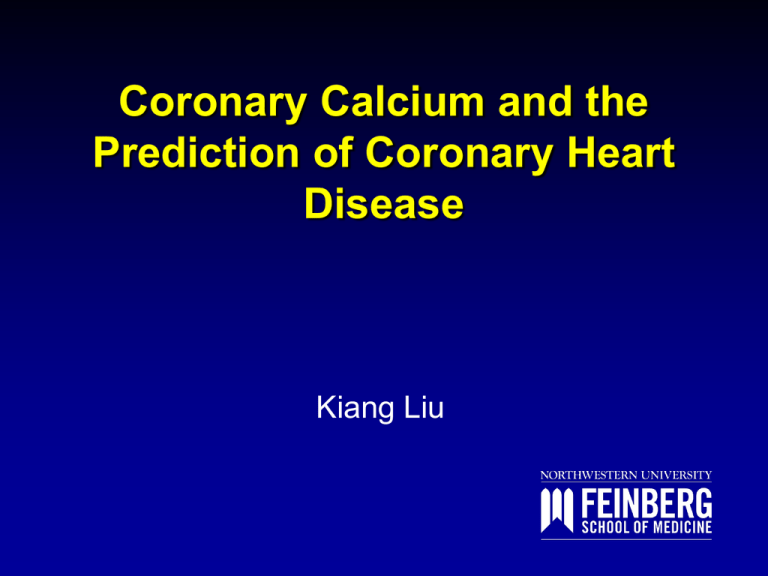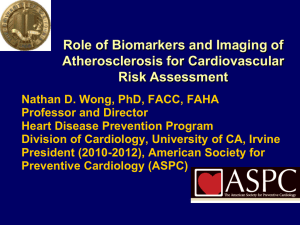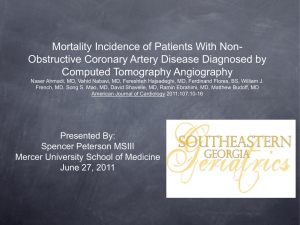
Coronary Calcium and the
Prediction of Coronary Heart
Disease
Kiang Liu
Overview
• Why Should We Study Subclinical Cardiovascular
Disease (CVD)?
• Coronary Calcium and the Prediction of Coronary
Events
• MESA Findings on Ethnic Differences of Coronary
Calcium and on Coronary Calcium and the Prediction
of Coronary Events
• Improvement of Using CAC to Identify People at High
Risk for Coronary Events
• Conclusions
Why Should We Study
Subclinical CVD?
Crude Death Rates for Selected
Causes, U.S., 1950-2006
From NHLBI Chartbook, 2009
Leading Causes of Death
U.S., 2006
Cause of Death
Number
Total
2,426,264
1
Heart Disease *
631,636
2
Cancer
559,888
3
Cerebrovascular Disease (stroke)
137,119
4
COPD and allied conditions **
124,583
5
Accidents
121,599
6
Diabetes
72,449
7
Alzheimer’s disease
72,432
8
Influenza and pneumonia
56,326
9
Nephritis
45,344
Septicemia
34,234
10
All other causes of death
* Includes 425,425 deaths from coronary heart disease
** Chronic lower respiratory diseases.
From NHLBI Chartbook, 2009
570,654
Total Cholesterol Distribution
CHD vs Non-CHD Population
Framingham Heart Study—26-Year Follow-up
No CHD
35% of CHD
occurs in people
with TC<200 mg/dL
CHD
150
200
250
Total Cholesterol (mg/dL)
Adapted from Castelli WP. Atherosclerosis. 1996;124(suppl):S1-S9.
300
Percentage of MRFIT Men
with 1+, 2+, or 3+ Risk Factors by age group
19-year follow-up for CHD mortality
RISK
FACTOR
STATUS
CHD Death
All Other
CHD Death
All Other
Number
1,112
67,572
12,689
237,767
1+ RISK
FACTORS
98.6%
(97.9-99.3)
89.8%
(89.6-90.0)
98.8%
(98.6-99.0)
93.6%
(93.5-93.7)
2+ RISK
FACTORS
85.8%
(83.7-87.9)
57.8%
(57.4-58.2)
86.1%
(85.5-86.7)
65.6%
(65.4-65.8)
3+ RISK
FACTORS
46.9%
(44.0-49.8)
17.0%
(16.7-17.3)
38.9%
(38.1-39.7)
18.4%
(18.2-18.6)
AGES 35-39
AGES 40-57
Adapted from Greenland et al. JAMA. 2003; 290: 891-7.
Subclinical Cardiovascular
Disease (CVD)
Subclinical disease: No manifest disease, but
pathogenic changes have occurred
Identify people at high risk if subclinical CVD
can be detected non-invasively before it
produces clinical signs and symptoms
Measures of Subclinical CVD
Examples:
• Coronary Calcium Score
• Carotid IMT
• Flow Mediated Vasodilation
• Ankle Brachial Index
• Cardiac MRI measures
• Biomarkers
Coronary Calcium and the Prediction
of Coronary Events
EBT Coronary Calcium Screen
No Coronary
Artery Calcium
Extensive Coronary
Artery Calcium
Graph showing square-root sum of coronary calcium areas
(mm) by electron-beam computed tomography vs. square-root
sum of atherosclerotic plaque areas (mm) for each of the
individual coronary arteries studied (n=38)
Rumberger, J. A. et al. Circulation. 1995;92:2157-62
Studies on Coronary Calcium as a
Predictor of Coronary Events
Size
Average
Follow-up
(Months)
Detrano et al.
JACC 1996
4221
(55 11 yrs)
Arad et al.
Circulation 1996
11732
(55 11 yrs)
Study
Arad et al.
JACC 1998 Abstract
Risk Ratio
30
MI + cardiac
deaths
Q4 vs. Q1
RR=10
19
MI, CABG,
PTCA, cardiac
death
Calcium score >160 vs.
160
OR = 35.4
43
OR=23
32
MI + cardiac
death
revasc
Log calcium score5
OR=1.24(NS)
OR=2.87
3672
(52 yrs)
36-72
Angina, MI,
angiography,
CABG, PTCA
Calcium score ≥ 50 vs. 0
OR = 6.87
11964
(66 8 yrs)
44
MI, cardiac
death, revasc
No significant
improvement of ROC
curve area6
Secci et al.
Circulation 1997
3263
(66 8 yrs)
Agatston et al.
Circulation 1996
Detrano et al.
Circulation 1999
1
Events
Patients underwent angiography
Asymptomatic subjects
3 High-risk subjects
4 High-risk asymptomatic subjects
5 Adjusting for age and CVD risk factors
6 No significant improvement of ROC curve area in addition to CVD Risk model
2
Association Between CAC Score
Categories and Hard Events in Men
CAC Score Relative Risk 95% CI
Range
0.0
1.0†
Referent
Quartile 1
1.0-3.8
1.76
0.39-7.88
Quartile 2
4.0-30.5
2.84
0.73-11.11
Quartile 3
31-169
5.61†
1.57-20.06
Quartile 4
170-7,000
7.24†
2.01-26.15
The multivariable Cox proportional-hazards regression analysis was performed with adjustment
for age and other CAD risk factors.
†0.001<P<0.01
Kondos, et al. Circulation. 2003;107:2571-6.
Multivariable Association Between CAC
and Cardiac Events (Hazard Ratio)
Men
Hard events 3.86* (1.17-12.70)
Women
1.53 (0.23-10.09)
Soft events
26.8† (3.72-193.11) 3.08* (1.11-8.58)
All events
10.46† (3.85-28.40) 2.57* (1.06-6.23)
*0.01 < P < 0.05
†0.001 < P < 0.01
Kondos, et al. Circulation. 2003;107:2571-6.
MESA Findings on Coronary
Calcium and the Prediction of
Coronary Events
Multi-Ethnic Study
of Atherosclerosis
MESA
• An NHLBI-sponsored multi-center study investigating
prevalence, correlates, and progression of
subclinical CVD (i.e., disease detected noninvasively
before it produces clinical signs and symptoms) in a
population-based sample of 6,814 men and women
aged 45-84.
• 6 U.S. field centers recruited healthy men and
women (~50% each sex) from 4 racial/ethnic groups
(42% white, 13% Chinese, 24% African-American,
and 21% Hispanic).
Multi-Ethnic Study
of Atherosclerosis
MESA
Objectives
To determine characteristics related to progression
of subclinical to clinical CVD.
To determine characteristics related to progression
of subclinical CVD.
To assess ethnic, age, and gender differences in
subclinical disease prevalence and risk of
progression to clinical cardiovascular disease
Collaborating Centers
in MESA
• Univ of Washington
• Univ of MN
• U of Vermont
• New Engl Med Cntr
• Northwestern Univ •Columbia
•Johns Hopkins
• UCLA (2)
• Wake Forest
Cohort Characteristics - Men
White
African A
(n=1218) (n=815)
Hispanic
(n=700)
Chinese
(n=379)
P Value†
Age, yrs
63.3
62.8
61.7***
63.1
.009
% <HS
3.8
12.4***
42.1***
16.7***
< .0001
BMI
27.9
28.8***
28.7***
24.0***
< .0001
Waist, cm
100.8
100.7
100.8
87.7***
< .0001
% current smoker
11.3
19.5***
15.7**
9.9
< .0001
% former smoker
48.8
42.8**
45.3
36.9***
.0003
Alcohol, dk/wk
6.8
4.4***
5.2***
2.8***
< .0001
Age adjusted; *p< 0.05; **p<0.01; ***p<0.001 compared to White; †P values for overall group comparisons
Cohort Characteristics - Men, continued
P Value§
White African A
Hispanic Chinese
SBP, mmHg
123.6
130.1***
126.2**
123.5
<.0001
DBP, mmHg
73.7
77.1***
74.8*
74.8
<.0001
LDL-C, mg/dl
117.3
113.5**
118.9
116.7
.006
HDL-C, mg/dl
45.3
46.8**
42.8***
45.9
<.0001
TG, mg/dL
127.9
105.9***
153.4***
136.2*
<.0001
Glucose mg/dl
101.2
108.9***
113.4***
109.0***
<.0001
%
Hypertension†
36.8
57.1***
38.6
34.6
<.0001
% Diabetes
8.1
20.4***
20.6***
14.1***
<.0001
% Chol Rx
18.4
15.0*
13.2**
13.6*
.008
Age adjusted;*p< 0.05; **p<0.01; ***p<0.001 compared to White; †BP >140/90 or reported to be on antihypertensive medication; ‡Fasting glucose >126 mg/dl or on hypoglycemic medication;§P values for overall group
comparisons
Cohort Characteristics - Women
White
African A
(n=1313) (n=1019)
Hispanic
(n=750)
Chinese
(n=404)
P Value†
Age, yrs
63.0
62.6
62.1
62.8
.26
% <HS
5.5
11.7***
48.1***
31.3***
< .0001
BMI
27.5
31.3***
30.0***
23.9***
< .0001
Waist, cm
94.9
101.6***
100.5***
86.4***
< .0001
% current smoker
11.7
15.9**
9.8
1.3***
< .0001
% former smoker
39.9
31.9***
21.3***
2.2***
< .0001
Alcohol, dk/wk
3.4
1.9***
1.2***
0.8***
< .0001
Age adjusted; *p< 0.05; **p<0.01; ***p<0.001 compared to White; †P values for overall group comparisons
Cohort Characteristics - Women, continued
White
African A
Hispanic Chinese
P Value§
SBP, mmHg
122.4 132.9***
128.3***
125.1*
<.0001
DBP, mmHg
66.9
72.5***
68.4**
69.2***
<.0001
LDL-C, mg/dl
117.1
118.7
119.8
113.9
.01
HDL-C, mg/dl
59.0
57.0**
52.7***
53.3***
<.0001
TG, mg/dl
126.8 99.2***
143.1***
137.0**
<.0001
Glucose mg/dl
94.8
105.2***
107.9***
102.5*** <.0001
% Hypertension† 36.4
61.1***
46.5***
40.3
<.0001
% Diabetes
4.9
17.1***
17.4***
13.3***
<.0001
% Chol Rx
16.2
18.4
15.5
15.5
.26
Age adjusted;*p< 0.05; **p<0.01; ***p<0.001 compared to White; †BP >140/90 or reported to be on antihypertensive medication; ‡Fasting glucose >126 mg/dl or on hypoglycemic medication;§P values for overall group
comparisons
Age-Adjusted Prevalence of Coronary
Calcium (CAC) > 20
100
80
60
40
55
*** ***
*** 43 44
38
31 *** *** 30
25 22
20
0
Men
Women
*p< 0.05, **p<0.01, ***p<0.001 compared to White.
White
African American
Hispanic
Chinese
Unadjusted Kaplan–Meier Cumulative-Event Curves for
Major Incident CHD by CAC Score, MESA
Rates for major coronary events (myocardial infarction and
death from coronary heart disease)
Differences among all curves are statistically significant (P<0.001).
Detrano, et al. N Engl J Med. 2008;358:13.
Unadjusted Kaplan–Meier Cumulative-Event Curves for
Any Incident CHD by CAC Score, MESA
Rates for any coronary event
Differences among all curves are statistically significant (P<0.001).
Detrano, et al. N Engl J Med. 2008;358:13.
Risk Factor Adjusted Risk of Incident
CHD by CAC Score, MESA
Major Coronary Event†
Coronary-Artery
Calcium Score
No./No.
at Risk
Hazard Ratio
(95% CI)
0
8/3409
1.00
1-100
25/1728
3.89 (1.72-8.79)
101-300
24/752
>300
32/833
Log2 (CAC+1) §
†Major
§Each
Any Coronary Event
P
Value
No./No. at
Risk
Hazard Ratio
(95% CI)
15/3409
1.00
<0.001
39/1728
3.61 (1.96-6.65)
<0.001
7.08 (3.05-16.47)
<0.001
41/752
7.73 (4.13-14.47)
<0.001
6.84 (2.93-15.99)
<0.001
67/833
9.67 (5.20-17.98)
<0.001
1.20 (1.12-1.29)
<0.001
1.26 (1.19-1.33)
<0.001
coronary events are myocardial infarction and death from coronary heart disease
unit increase in log2 (CAC+1) represents a doubling of the coronary-artery calcium score
Detrano, et al. N Engl J Med. 2008;358:13.
P
Value
Risk of Incident CHD Associated with CAC
Score in Four Racial or Ethnic Groups*
Major Coronary Event†
Racial or
Ethnic
Group
Any Coronary Event
No.
Hazard Ratio
(95% CI)§
P Value
No.
Hazard Ratio
(95% CI)
P Value
White
41
1.17 (1.06-1.30)
<0.005
74
1.22 (1.13-1.32)
<0.001
Chinese
6
1.25 (0.95-1.63)
0.11
14
1.36 (1.12-1.66)
<0.005
Black
18
1.35 (1.16-1.57)
<0.001
38
1.39 (1.25-1.56)
<0.001
Hispanic
24
1.15 (1.02-1.29)
<0.025
36
1.18 (1.07-1.30)
<0.001
*CAC denotes coronary-artery calcium score and CI confidence interval
†Major coronary events are myocardial infarction and death from coronary heart disease
§Hazard ratios were calculated with the use of Cox regression for coronary heart disease (major event and any
event) for baseline levels of log2 (CAC+1) after adjustment for risk factors and interactions between racial or ethnic
group and coronary calcium score and between racial or ethnic group and diabetes (the only significant
interaction). Hazard ratios are calculated on the basis of a doubling of CAC+1
Detrano, et al. N Engl J Med. 2008;358:13.
Area under the Curve (AUC), Risk Factors vs. Risk
Factors plus CAC Score to Predict Incident CHD
by Race or Ethnicity*, MESA Study
Major Coronary Event†
Racial or
Ethnic
Group
Any Coronary Event
AUC for
Risk
Factors
Alone
AUC for Risk
Factors plus
Coronary Artery
Calcium Score
P Value
AUC for Risk
Factors Alone
AUC for Risk
Factors plus
Coronary Artery
Calcium Score
P Value
White
0.76
0.79
0.10
0.75
0.79
0.02
Chinese
0.83
0.88
0.05
0.74
0.85
<0.001
Black
0.79
0.87
0.04
0.81
0.87
0.005
Hispanic
0.84
0.86
0.11
0.80
0.84
0.10
Total
0.79
0.83
0.006
0.77
0.82
<0.001
*Separate models are fitted for each racial or ethnic group. AUC denotes area under the receiver-operating characteristic
curve. P values are for the comparison between AUC without and AUC with the coronary-artery calcium score.
†Major coronary events are myocardial infarction and death from coronary heart disease
Detrano, et al. N Engl J Med. 2008;358:13.
Hazard Ratios (HRs) for an Incident CVD, CHD, or Stroke Event in
Relation to a 1-SD Increment of Maximal Carotid IMT or CAC Score
(MESA 2000-04)
Measure*
CVD (n = 222)
Age-, race-, and sex-adjusted
z Score max IMT
In(CAC score + 1)
Multivariable-Adjustedb
z Score max IMT
In(CAC score + 1)
CHD (n = 159)
Age-, race-, and sex-adjusted
z Score max IMT
In(CAC score + 1)
Multivariable-Adjustedb
z Score max IMT
In(CAC score + 1)
Stroke (n = 59)
Age-, race-, and sex-adjusted
z Score max IMT
In(CAC score + 1)
Multivariable-Adjustedb
z Score max IMT
In(CAC score + 1)
HR Per 1-SD Increment Z Statistic
(95% CI)
P Value
1.3 (1.1-1.4)
2.1 (1.8-2.5)
4.1
8.6
<.001
<.001
1.2 (1.0-1.3)
1.9 (1.6-2.2)
2.7
7.5
.007
<.001
1.2 (1.0-1.4)
2.5 (2.1-3.1)
2.5
8.8
.01
<.001
1.1 (1.0-1.3)
2.3 (1.9-2.8)
1.5
7.9
.12
<.001
1.4 (1.2-1.8)
1.1 (0.8-1.5)
3.5
0.8
.001
.41
1.3 (1.1-1.7)
1.1 (0.8-1.4)
2.5
0.4
.01
.71
Folsom, et al. Arch Intern Med. 2008;168:12.
Abbreviations: CAC, coronary artery calcium; CHD, coronary heart disease; CVD, cardiovascular disease; IMT, intimamedia thickness; max, maximum; MESA, Multi-Ethnic Study of Atherosclerosis
*Coronary artery calcium score and IMT were in the same model bAdjusted as described in the “Methods” section
Hazard Ratios (HR) for Incident CVD, CHD, or Stroke Event in Relation
to Quartiles of Maximal Carotid IMT or CAC Score (MESA 2000-04)
HR (95% Cl)
Measure*
CVD (n = 222)
Age-, race-, and sex-adjusted
z Score max IMT
CAC Score
Multivariable-Adjustedb
z Score max IMT
CAC Score
CHD (n = 159)
Age-, race-, and sex-adjusted
z Score max IMT
CAC Score
Multivariable-Adjustedb
z Score max IMT
CAC score
Stroke (n = 59)
Age-, race-, and sex-adjusted
z Score max IMT
CAC Score
Multivariable-Adjustedb
z Score max IMT
CAC score
<50th
Percentile
X2
P Value
Statistic
Quartile 3
Quartile 4
1 [Reference]
1 [Reference]
1.4 (0.9-2.0)
2.6 (1.6-4.1)
2.2 (1.5-3.2)
5.3 (3.4-8.2)
20.1
58.4
<.001
<.001
1 [Reference]
1 [Reference]
1.3 (0.9-2.0)
2.3 (1.5-3.7)
1.7 (1.2-2.5)
4.4 (2.8-6.8)
8.7
44.7
.01
<.001
1 [Reference]
1 [Reference]
1.5 (1.0-2.4)
4.1 (2.2-2.7)
2.1 (1.4-3.3)
10.3 (5.6-18.9)
11.5
63.8
<.01
<.001
1 [Reference]
1 [Reference]
1.5 (0.9-2.3)
3.5 (1.9-6.6)
1.7 (1.1-2.7)
8.2 (4.5-15.1)
5.4
51.5
.07
<.001
1 [Reference]
1 [Reference]
0.9 (0.4-2.0)
1.4 (0.8-2.7)
2.4 (1.2-4.7)
1.2 (0.6-2.4)
9.9
0.7
<.01
.70
1 [Reference]
1 [Reference]
0.9 (0.4-2.0)
1.3 (0.6-2.6)
1.8 (0.9-3.6)
1.0 (0.5-2.1)
4.7
0.6
.10
.73
Folsom, et al. Arch Intern Med. 2008;168:12.
Abbreviations: CAC, coronary artery calcium; CHD, coronary heart disease; CVD, cardiovascular disease; IMT,
intima-media thickness; max, maximum; MESA, Multi-Ethnic Study of Atherosclerosis
*Coronary artery calcium score and IMT were in the same model bAdjusted as described in the “Methods” section
Prevalence of High CAC Score in People
with Different Risk Factor Status, MESA
% of CAC ≥ 100
50
40
30
20
10
0
0
1
Men
% 100 ≤ CAC< 300
% 300 ≤ CAC
2
3+
0
1
Number of Risk Factors
2
3+
Women
Risk Factors: LDL ≥ 130 mg/dl or Rx; BP 140/90 mmHg or Rx; fasting glucose ≥ 126 mg/dl or Rx;
current smoker
Improvement of Using CAC to
Identify People at High Risk for
Coronary Events
Current Paradigm for Risk Estimation
and Treatment: ATP-III
“Intensity of prevention efforts should match
the absolute risk of the patient”
Estimate 10-year risk (FRS)
<10%
10-20%
>20% or DM
Further testing
Lifestyle
modification
Lifestyle
and drug therapy
Calculation of the NRI
Proportion of events and nonevents correctly
reclassified
Events reclassified higher – events reclassified lower
Total number of events
PLUS
Nonevents reclassified lower – nonevents reclassified higher
Total number of nonevents
Pencina et al. Statist. Med. 2008;27:157-72
Participants not reclassified
5-Year Risk from Model with CAC
5-Year Risk from Model
without CAC
0% to <3%, n=3,746
Events, n
Proportion with events
3% to 10%, n=1847
Events, n
Proportion with events
>10%, n=285
Events, n
Proportion with events
0% to <3%
3% to 10%
>10%
3,310
34
0.9
843
52
5.4
183
28
14.4
Participants reclassified to higher risk
5-Year Risk from Model with CAC
5-Year Risk from Model
without CAC
0% to <3%, n=3,746
Events, n
Proportion with events
3% to 10%, n=1847
Events, n
Proportion with events
>10%, n=285
Events, n
Proportion with events
0% to <3%
3% to 10%
>10%
430
22
4.8
6
1
20.0
292
48
14.8
Participants reclassified to lower risk
5-Year Risk from Model with CAC
5-Year Risk from Model
without CAC
0% to <3%, n=3,746
Events, n
Proportion with events
0% to <3%
3% to 10%, n=1847
Events, n
Proportion with events
712
15
1.9
>10%, n=285
Events, n
Proportion with events
32
2
6.2
3% to 10%
70
7
8.9
>10%
Calculation of NRI
NRI for events: 0.23
PLUS
=
0.25
(95% CI 0.16-0.34
NRI for non-events: 0.02
P<0.001)
Reclassification among intermediate
risk participants
• Among 1847 intermediate risk participants, 39%
were reclassified to low risk and 16% were
reclassified to high risk
– NRI = 0.55 (95% CI 0.41-0.69, P<0.001)
– NRI = 0.29 for events and 0.26 for nonevents
• 115 events occurred among intermediate risk
participants; 48 were among people reclassified
to high risk and 15 were among those
reclassified to low risk
CAC Prevalence, Amount and ‘Number Needed to Screen’
Compared with Framingham Risk Score Categories
CAC Score Group Framingham Risk Score Categories (n = 5660)
5.10-2.5% 2.6-5%
7.6-10% 10.1-15%
7.5%
(1730) (1045)
(779)
(617)
(442)
Median CAC
28.6
39.7
62.5
71.5
111.6
score > 0
(7.4,
(11.9,
(15.9,
(19.3,
(27.7,
(IQR)
91.6)
140.6)
211.2)
257)
284.1)
CAC > 0: n, (%)
N = 2626
NNS (CAC > 0)
386
(22.3)
4.5
CAC ≥ 100: n, (%) 89
N = 1163
(5.1)
NNS (CAC ≥ 100) 19.4
411
(39.3)
2.5
198
(44.8)
2.2
449
(57.6)
1.7
394
(63.9)
1.6
132
(12.6)
7.9
81
(18.3)
5.5
193
(24.8)
4.0
205
(33.2)
3.0
15.1-20% > 20%
(793)
(254)
134.6
(33.5,
427.6)
198.6
(56.5,
483.7)
579 (73)
209 (82.3)
1.4
1.2
324
(40.9)
2.5
139 (54.7)
p
value
< 0.01
< 0.01
1.8
CAC ≥ 300: n, (%) 29
102
191
46 (4.4) 33 (7.5)
96 (15.6)
77 (30.3)
< 0.01
N = 574
(1.7)
(13.1)
(24.1)
NNS (CAC ≥ 300) 59.7
22.7
13.4
7.6
6.4
4.2
3.3
IQR: Interquartile Range CAC (25th percentile, 75th percentile)
NNS: Number needed to screen to identify one individual with CAC value above a specified CAC cutoff point, within
each specified FRS stratum
Okwuosa TM, et al. Distribution of Coronary Artery Calcium Scores by Framingham 10-Year Risk Strata in the MultiEthnic Study of Atherosclerosis (MESA): Potential Implications for Coronary Risk Assessment. J Am Coll Cardiol 2011.
Conclusions
Coronary calcium score is strongly associated with
incident coronary heart disease and provides
additional predictive information beyond that provided
by standard risk factors in four major racial and ethnic
groups in the U.S.A.
However the CT scan to detect coronary calcium
produces radiation exposure that is equivalent to one
year’s exposure from natural sources.
Coronary calcium scores may be used to screen
asymptomatic patients who have multiple CVD risk
factors or whose Framingham Risk Scores are in the
intermediate range.
Age-Adjusted CHD Mortality Rate per 10,000
Person Years by SBP, Cholesterol, and Smoking
MRFIT Screenee Study
70
60
50
Smokers
40
Non-Smokers
30
20
10
0
2+ 4 1 1
4
1 -1 13 4
2 2
13 12 5 1 8-1 <118
1
Neaton JD,
Wentworth D.
Arch Intern Med.
1992;152:56
SBP
(mmHg)
2+
14 -14 1 3 1 4
2
1
13 12 5- 8-12 118
<
11
<1
82
24
5+
20
3-2
2 0 Cholesterol
(ml/dl)
Additional Findings
Lumbar Bone Density and ABI, CAC, and AAC
Baseline CAC and coronary artery stenoses during
follow-up
ECG abnormalities and CAC and carotid IMT
Incidence and progression of aortic valve calcium;
relationship between aortic valve calcium and severity
of CAC
Arterial age as a function of CAC
Incident CHD and CVD by CAC Score in Low
Risk1 Women Based on FRS, MESA
No. of Events/
Total No. (%)
Unadjusted HR
P Value Adjusted HR ‡
0
1-99
100-299
≥300
6/1814 (0.3)
8/589 (1.4)
3/176 (1.7)
7/105 (6.7)
1 [Reference]
4.2 (1.5-12.0)
5.7 (1.4-22.9)
22.3 (7.5-66.5)
.008
.01
<.001
1 [Reference]
2.4 (0.8-7.3)
1.5 (0.3-8.3)
8.3 (2.3-30.0)
.12
.63
.001
0
1-99
100-299
≥300
10/1814 (0.6)
11/589 (1.9)
4/176 (2.3)
9/105 (8.6)
1 [Reference]
3.4 (1.5-8.1)
4.5 (1.4-14.3)
17.3 (7.0-42.5)
.005
.01
<.001
1 [Reference]
2.0 (0.8-4.9)
1.4 (0.4-5.6)
6.0 (2.1-17.2)
.13
.62
.001
CAC Score
P Value
CHD
CVD
1Low
Risk: FRS<10%
for age, ethnicity, body mass index, low-density lipoprotein cholesterol level, hypertension,
smoking, family history of CHD, estrogen use and statin use
‡Adjusted
Lakoski, et al. Arch Intern Med. 2007;167:22.
Results
• Final cohort of 5878 participants
• 209 CHD events, overall event rate 3.5%
– 122 major events (96 MI, 14 death from CHD, 12
resuscitated cardiac arrest)
– 87 angina events (73 followed by revascularization, 14
not followed by revascularization)
• AUROC using traditional risk factors was 0.76, increased to
0.81 with the addition of CAC (P<0.001)
• Both models well calibrated
– HL χ2 statistic model 1: 6.72, P=0.46;
model 2: 9.15 P=0.24
Polonsky et al JAMA 2010








